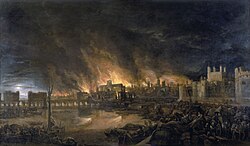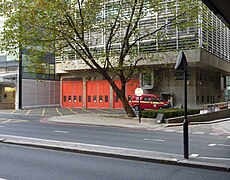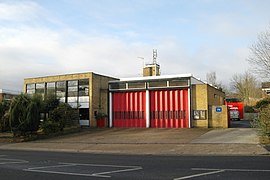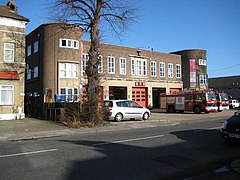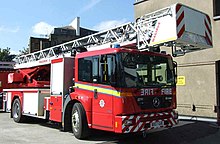London Fire Brigade
|
|||
|---|---|---|---|
| State level | region | ||
| Position of the authority | Professional fire brigade | ||
| Supervisory authority (s) | Greater London Authority | ||
| Consist | since 1904 | ||
| Arose from | Metropolitan Fire Brigade (founded 1866) |
||
| Headquarters | London , 169 Union Street, SE1 | ||
| household | £ 434,200.00 | ||
| Coordinates | 51 ° 30 '12.9 " N , 0 ° 5' 54.9" W | ||
| Commissioner | Dany Cotton | ||
| Employee | 5,992 | ||
| Website | www.london-fire.gov.uk/index.asp | ||

The London Fire Brigade (LFB) is the professional fire service of the British capital London . It was founded in 1866 under Superintendent Eyre Massey Shaw as the Metropolitan Fire Brigade (MFB) and is now the second largest fire service in the United Kingdom and after the fire protection authorities with around 6,000 employees at 103 fire stations and in administration after the Scottish Fire and Rescue Service from Tokyo , New York and Paris the fifth largest fire department in the world.
The responsibility of the LFB extends to the entire area of the Greater London administrative district (consisting of the City of London and the 32 London Boroughs ) with its 8,538,689 inhabitants (as of June 30, 2015). In its capacity as fire protection authority, the LFB is responsible for defensive and preventive fire protection as well as for technical assistance , for example in the event of traffic accidents, accidents with nuclear, biological or chemical hazardous substances or natural events. The tasks of the LFB, however, do not include the implementation of the rescue service ( emergency rescue and ambulance transport ) in London; The responsibility for this lies within the National Health Service (NHS) with the London Ambulance Service .
history
First fire brigades
As a consequence of the Great Fire of London in September 1666, which destroyed around 400 streets and more than 13,000 houses in the London metropolitan area, several London insurance companies began to set up their own fire protection units especially for the citizens insured with them. The houses of the insured were marked with badges, so that the firefighters could see whether the residents of the house were insured and were therefore entitled to assistance in the event of a fire. As a result of this, firefighters from several different units would not infrequently arrive in the event of a fire to first look for the signs of their insurance on the affected building. If there was no such marking, the men did not provide any help, but left the scene without having achieved anything.
The Royal Society for the Protection of Life from Fire (RSPLF) was founded in 1828 as a reaction to the largely poorly equipped and poorly trained fire brigades of the insurance companies and in order to be able to provide help in fires also to uninsured citizens . The RSPLF had mobile ladders for rescuing people from burning buildings up to a height of approx. 20 meters. The RSPLF staff had to complete several months of training in order to be able to operate the ladders safely.
Establishment of the Metropolitan Fire Brigade

Just five years later - in 1833 - ten fire insurance companies joined forces and founded the London Fire Engine Establishment (LFEE). However, a few major fires in the following years, in particular the destruction of the Palace of Westminster on October 16, 1834 and the devastating fire of a cotton factory in Tooley Street on June 22, 1861, made fire-fighting unprofitable and therefore unattractive for insurance companies and the companies therefore demanded that the city administration take over the fire department.
This demand was met in 1866 with the Metropolitan Fire Brigade Act , which led to the establishment of the Metropolitan Fire Brigade (MFB) as the first urban fire department in London. The first head of the MFB (initially Superintendent , later called Chief Officer ) was Eyre Massey Shaw, who held this office for 25 years until 1891. Under his responsibility, the organization of fire services in London was fundamentally reformed. Among other things, the firefighters were equipped with new protective clothing made of wool and new fire stations were set up. During Shaw's tenure, the first steam-powered fire pumps were also put into service with the London Fire Department.
In 1904, under Superintendent Rear Admiral Hamilton, the MFB was renamed the London Fire Brigade (LFB) and moved to new headquarters in the Lambeth borough . She kept this seat until another move in 2007.
Before and during World War II
Due to the increasing political tensions in Europe before the outbreak of the Second World War , the British Parliament passed a law in the second half of the 1930s that allowed the establishment of volunteer fire departments so that the structures of the British fire departments can grow up quickly in the event of war. Accordingly, the Auxiliary Fire Service (AFS) was founded in London in 1938, one year before the start of the war, a unit comprising around 28,000 firefighters that was supposed to support the 2,500 full-time firefighters of the LFB in the event of fires as a result of bombing. The equipment of the AFS was makeshiftly housed in schools, companies or private garages. During the Second World War, all fire departments in the United Kingdom were finally merged into a single National Fire Service (NFS) . In 1943 the NFS comprised around 70,000 emergency services. For the first time in the British fire service, women were also allowed to work in the fire service, but not in fire fighting, but in telecommunications technology or as fire observers, for example.
Modernization in the post-war period
After the end of the Second World War in May 1945, the NFS initially existed, but discussions began about a reorganization of the fire service in the United Kingdom . This ended with the responsibility for the structures of the fire brigade being transferred back to the lower administrative levels, the counties . As a result, the LFB was re-established on April 1, 1948. In the following years the Fire Brigade underwent an extensive modernization process under Chief Officer Sir Frederick Delve. Among other things, large parts of the vehicle fleet were renewed, breathing apparatus introduced, the role of preventive fire protection strengthened and the emergency call system introduced via the emergency number 999 . With the formation of the Greater London administrative district and its authority, the Greater London Council (GLC) , in 1965, the previously independent fire departments of Middlesex , West Ham , East Ham and Croydon as well as parts of the fire departments of Essex , Hertfordshire , Surrey and Kent became part of the LFB incorporated.
Development until today
In 1986 the Greater London Council (GLC) was dissolved and the LFB was placed under the supervision of the newly created London Fire and Civil Defense Authority (LFCDA) . The LFCDA was replaced on July 3, 2000 by the London Fire and Emergency Planning Authority (LFEPA) , a 17-member committee of the Greater London Authority (GLA), the administrative authority of the Mayor of London . In 2007 the LFB moved to its new headquarters at 169 Union Street in Southwark .
With its 5,992 employees, including 5,096 firefighters on duty, at a total of 103 fire stations , the LFB is now the fifth largest fire service in the world (after the fire services of Tokyo , New York , Paris and the Scottish Fire and Rescue Service ). In 2013/2014, the London Fire Brigade's Emergency Call Center answered and handled a total of 171,067 calls to the 999 emergency number . The requests for help resulted in 20,934 fire operations which were processed by the LFB emergency services. This makes the LFB one of the busiest fire departments in the world.
organization
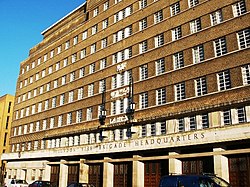
Management and administration
The LFB is part of the Greater London administrative district and is subordinate to the London Fire and Emergency Planning Authority (LFEPA) . The LFEPA is a 17-member committee of the Greater London Authority (GLA), the administrative authority of the Mayor of London . It coordinates all planning and measures of security in London and performs the supervision of the LFB. The 17 members of the LFEPA are each appointed for a period of one year by the Mayor of London and are composed as follows:
- eight representatives of the London Assembly (city parliament),
- seven representatives of the London Boroughs (boroughs),
- two additional members appointed by the Mayor of London .
The LFB itself is subordinate to the Commissioner for Fire and Emergency Planning . The current commissioner of the LFB since January 2017 is Dany Cotton QFSM.
The level of the administrative structure of the LFB, which is subordinate to the Commissioner and which was only revised in December 2015, consists of the three so-called Directorates , each of which is led by a Director :
- Directorate of Finance and Contractual Services ,
- Directorate of Operations (deployment),
- Directorate of Safety and Assurance (occupational safety and quality assurance).
In addition, there is a staff unit for public relations, for legal matters and for strategic planning, which are directly assigned to the commissioner .
The main administration was in the period from 1904 to 2007 in the London borough of Lambeth . Since 2007, the LFEPA (regulator, Fiona Twycross) and LFB administration have been located at 169 Union Street in the Southwark borough .
Fire stations
Originally the LFB was organizationally divided into two divisions: North and South. The two areas were separated by the Thames . Each division was subordinate to a divisional officer and was in turn divided into three districts. In each district a so-called superintendent was in command of the units subordinate to him. The line of fire stations , station called, each was responsible for a station officer .
Today the 103 fire stations belong to the Directorate of Operations of the LFB and are subordinate to the so-called Assistant Commissioner Fire Stations , who is located in the hierarchy of the LFB below the Commissioner and the Directors . Several fire stations are groups ( Groups together), adjacent groups form the so-called regions ( areas ) whose line per a Deputy Assistant Commissioner responsible. In its current structure (as of December 2015), the LFB is divided into four areas: North East , North West , South East and South West .
North East Area
The North East Area includes 27 fire stations in the boroughs of Havering (24), Newham (27), Waltham Forest (28), Barking and Dagenham (25), Tower Hamlets (8), Redbridge (26), Hackney (9), Islington (10) and City of London (1).
| Group | M72 Havering | M81 Newham | M87 Waltham Forest | M57 Barking and Dagenham | M86 Tower Hamlets | M82 redbridge | M68 Hackney | M75 Islington | M63 City of London |
|---|---|---|---|---|---|---|---|---|---|
| Stations | Romford | Stratford | Leyton | Dagenham | Poplar | Woodford | Stoke Newington | Islington | Dowgate |
| Hornchurch | East Ham | Leytonstone | Barking | Millwall | Hainault | Homerton | Holloway | ||
| Wennington | Plaistow | Walthamstow | Bethnal Green | Ilford | Shoreditch | ||||
| Harold Hill | Chingford | Whitechapel | |||||||
| Shadwell |
North West Area
The North West Area includes a total of 28 fire stations in the boroughs of Brent (12), Hillingdon (33), Harrow (32), Ealing (13), Haringey (29), Hounslow (14), Camden (11), Barnet (31) and Enfield (30).
| Group | M60 Brent | M73 Hillingdon | M71 Harrow | M65 Ealing | M70 Haringey | M74 Hounslow | M62 Camden | M58 barnet | M66 Enfield |
|---|---|---|---|---|---|---|---|---|---|
| Stations | Willesden | Ruislip | Harrow | Ealing | Hornsey | Heston | Euston | Hendon | Enfield |
| Wembley | Heathrow | Stanmore | Acton | Tottenham | Chiswick | Kentish Town | Barnet | Southgate | |
| Park Royal | Hayes | Southall | Feltham | West Hampstead | Finchley | Edmonton | |||
| Hillingdon | Northolt | Mill Hill |
South East Area
Under the supervision of the South East Area Deputy Assistant Commissioner, there are 26 fire stations in the boroughs of Bexley (23), Croydon (19), Bromley (20), Greenwich (22), Southwark (7), Sutton (18), Lewisham (21 May ) ).
| Group | M59 Bexley | M64 Croydon | M61 Bromley | M67 Greenwich | M84 Southwark | M85 Sutton | M79 Lewisham |
|---|---|---|---|---|---|---|---|
| Stations | Erith | Addington | Beckenham | East Greenwich | Dockhead | Sutton | Lewisham |
| Bexley | Norbury | Biggin Hill | Eltham | Peckham | Wallington | Forest Hill | |
| Sidcup | Croydon | Bromley | Plumstead | Old Kent Road | Deptford | ||
| Purley | Orpington | Greenwich | New Cross | ||||
| Woodside | Lee Green |
South West Area
The South West Area comprises a total of 22 fire stations in the boroughs of Kensington and Chelsea (3), Merton (17), Richmond (15), Wandsworth (5), Hammersmith and Fulham (4), Lambeth (6), Kingston upon Thames (16 ) and City of Westminster (2).
| Group | M76 Kensington and Chelsea | M80 Merton | M83 Richmond | M88 Wandsworth | M69 Hammersmith and Fulham | M78 Lambeth | M77 Kingston | M89 City of Westminster |
|---|---|---|---|---|---|---|---|---|
| Stations | North Kensington | Mitcham | Richmond | Battersea | Fulham | Brixton | Kingston | Soho |
| Kensington | Wimbledon | Twickenham | Wandsworth | Hammersmith | Clapham | Surbiton | Paddington | |
| Chelsea | Tooting | West Norwood | New Malden | |||||
| Lambeth River | ||||||||
| Lambeth |
- Fire stations of the London Fire Brigade (selection)
Regional Control Center
The Regional Control Center is the LFB's emergency call center. It accepts incoming emergency calls, processes them and forwards them to the relevant fire brigade units. It therefore corresponds to the control centers or radio control centers (FEZ) of the fire services in German-speaking countries. The Regional Control Center has been based in the Merton district since 2011 .
Ranks
As with many other fire services in the United Kingdom , the 2003 LFB changed its rank designations. In August 2017, the London Fire Brigade announced that they would be returning to some of the old ranks.
Previous head of the London Fire Brigade
| No. | Surname | Beginning of the appointment | End of appointment | designation |
|---|---|---|---|---|
| 1 | Eyre Massey Shaw | 1866 | 1891 | Superintendent |
| 2 | James Sexton Simmonds | 1891 | 1896 | Superintendent |
| 3 | Wells | 1896 | 1903 | Superintendent |
| 4th | Hamilton | 1903 | 1909 | Superintendent |
| 5 | Sampson Sladen | 1909 | 1918 | Superintendent |
| 6th | Arthur Dyer | 1918 | 1933 | Superintendent |
| 7th | Cyril Moris | 1933 | 1938 | Superintendent |
| 8th | Aylmer Firebrace | 1938 | 1941 | Chief officer |
| 9 | Office not occupied | 1941 | 1948 | LFB taken up by the National Fire Service |
| 10 | Frederick Delve | 1948 | 1962 | Chief officer |
| 11 | Leslie Leete | 1962 | 1970 | Chief Officer, from 1965: Chief Fire Officer |
| 12 | Joseph Milner | 1970 | 1976 | Chief Fire Officer |
| 13 | Peter Darby | 1976 | 1980 | Chief Fire Officer |
| 14th | Ronald Bullers | 1980 | 1987 | Chief Fire Officer |
| 15th | Gerald Clarkson | 1987 | 1991 | Chief Fire Officer |
| 16 | Brian Robinson | 1991 | 2003 | Chief Fire Officer, from 2003: Commissioner for Fire and Emergency Planning |
| 17th | Ken Knight | 2003 | 2007 | Commissioner for Fire and Emergency Planning |
| 18th | Ron Dobson | 2007 | 2016 | Commissioner for Fire and Emergency Planning |
| 19th | Dany Cotton | 2017 | 2020 | Commissioner for Fire and Emergency Planning |
| 20th | Andy Roe | since 2020 | Commissioner for Fire and Emergency Planning |
Emergency vehicles
Dual-purpose ladder
The dual-purpose loaders (DPL) are the most versatile vehicles of the LFB. In addition to fire fighting equipment, the DPL also carry equipment and equipment for technical assistance and accident relief, such as a hydraulic rescue kit , a portable backup generator, lifting cushions of various sizes and two extension ladders. This type of vehicle can best be compared with the emergency fire fighting group vehicles used by German fire services.
Aerial appliances
The aerial appliances are the aerial rescue vehicles of the London Fire Brigade. LFB currently uses two different types of aerial appliances : the aerial ladder platforms ( telescopic mast ) and the turnable ladders ( turntable ladders ).
Fire rescue unit
A fire rescue unit (FRU) is an emergency vehicle that specializes in providing heavy technical assistance, for example after accidents with rail vehicles, building collapses or rescuing from heights, depths or rough terrain. The FRU is comparable to the rescue vehicles of German fire services.
Command support unit
Command support units (CSU) are used to manage and coordinate the deployed forces in large-scale operations. A CSU is alerted to every deployment in which more than four fire crews (most closely related to the German groups ) are active at a deployment site. Essentially, the task of the CSU consists of the transport of executives and their equipment, the provision of equipment for exploration and guidance as well as the handling of radio communication at the scene of operations and between the scene of operations and the control center . Corresponding vehicles at German fire brigades are called command vehicles.
Fire investigation unit
Fire investigation units (FIU) are called to fire operations where the cause of the fire is unknown and, together with the police, take over the investigation of the cause of the fire . Among other things, specially trained search dogs are also brought along at the FIU, which are used at the deployment site to track down flammable substances. There are no corresponding vehicles at fire brigades in Germany.
Operational support unit
The operational support unit (OSU) vehicle type has only existed at LFB since 2008. The OSU is used to transport special equipment and devices to the deployment site. The OSU equipment is loaded onto pallets and, depending on the location and requirements, can be loaded into the vehicles and brought to the deployment site. The OSU thus have similar tasks as the equipment vehicle logistics at German fire brigades.
Bulk foam unit
Bulk foam units (BFU) are alerted to operations that require large amounts of extinguishing foam for fire fighting, for example in the event of accidents with aircraft or with hazardous chemical substances. In terms of their tasks, the BFU are comparable to the roll-off containers foam or similar units used by German fire services.
Pants layer unit
The hose layer unit (HLU) is a type of vehicle that is alerted to fire operations if hydrants or other water extraction points are not available close enough to the scene of the incident . Instead, the vehicle ensures an alternative water supply using its large extinguishing water tank. Such vehicles hardly exist at German fire brigades, but the HLU can best be compared with corresponding roll-off containers for water transport.
Incident response unit
Incident response units (IRU) are fire fighting vehicles that were procured centrally by the British government after the September 11, 2001 attacks . They are used to set up decontamination sites after disasters or terrorist attacks. The vehicles are equipped with protective clothing, inflatable tents and decontamination showers.
High-volume pumping unit
Like the IRU, the high-volume pumping units (HVPU) are vehicles procured by the UK government for civil protection . You have a portable pump with a delivery rate of up to 8,000 liters per minute and extensive hose material. The HVPU are used to extract extinguishing water from bodies of water and to pump water over long distances. Corresponding vehicles for German fire brigades are the various expansion stages of the hose trolley or the Holland Fire System (HFS) .
Urban search and rescue prime movers
Urban search and rescue prime-movers (USAR) are units for heavy technical assistance. They are used to search for people and to clear rubble after building collapses and to support buildings or parts of buildings that are in danger of collapsing.
Scientific support unit
The Scientific Support Units (SSU) were procured by the LFB in response to the attacks on the London Underground on July 7, 2005 . They are used to transport extensive equipment for tracing and determining nuclear, biological and chemical warfare agents and hazardous substances. Corresponding vehicles in Germany are the measuring vehicles used by many fire brigades and in disaster control (e.g. measuring equipment trolleys).
Heavy distribution unit
The Heavy Distribution Unit (HDU) is a vehicle procured by LFB in 2010 to transport additional heavy equipment to the scene of the incident. In German fire brigades, such tasks are sometimes performed by trucks or swap bodies.
All-terrain unit
The all-terrain unit is a three-axle, all-terrain vehicle based on Land Rover . It is used to support the regular fire brigade units during operations in difficult terrain.
Instant response vehicle
In 2012 LFB purchased five Mini Countrymans and expanded them into so-called instant response vehicles (IRV) . The vehicles are manned by two emergency services and are equipped with six fire extinguishers (two each for water, foam and powder) and first aid equipment. You will be alerted in particular to small fires in which the use of larger units is not necessary, e.g. B. in trash can fires. The instant response vehicles are most comparable to the small emergency vehicles used by German fire brigades.
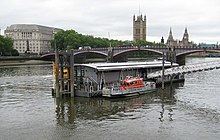
Fireboat
The LFB has two fire boats ( Fireboats ). They are named Fireflash and Firedart and are both stationed at the fireboat station in the Lambeth borough .
Car
In 2016, the LFB procured a total of 52 vehicles of the BMW i3 , which in the parlance of the Fire Brigade simply as car are called. The small cars are the first emergency vehicles at the London fire brigade with an electric motor and are used for a wide variety of purposes in daily work. For example, they are available to the fire stations for general official or courier trips.
general overview
The following overview shows all vehicle types used by the London Fire Brigade with the number of vehicles in active service and in reserve:
| Vehicle designation | active | reserve | current vehicle type |
|---|---|---|---|
| Dual-purpose ladder (DPL) | 102 | 45 | Mercedes-Benz Atego 1325F |
| Pump (P) | 55 | 0 | Mercedes-Benz Atego 1325F |
| Aerial ladder platform (ALP) | 7th | 5 | Mercedes-Benz Econic 2629 |
| Turnable ladder (TL) | 4th | 0 | Mercedes-Benz Econic 1828 |
| Fire rescue unit (FRU) | 16 | 3 | Mercedes-Benz Atego 1325F |
| Command support unit (CSU) | 8th | 1 | Mercedes-Benz Atego 1223NR |
| Fire investigation unit (FIU) | 6th | 0 | Volkswagen T5 |
| Operational support unit (OSU) | 6th | 1 | Mercedes-Benz Atego 1223NR |
| Bulk foam unit (BFU) | 3 | 0 | Mercedes-Benz Actros 2541 |
| Hose layer unit (HLU) | 4th | 1 | Mercedes-Benz Atego 1626F |
| Incident response unit (IRU) | 6th | 0 | MAN TGA 26.363 |
| High-volume pumping unit (HVPU) | 6th | 0 | MAN TGA 26.363 |
| Urban search and rescue prime mover (USAR) | 27 | 0 | MAN TGA 26.363 |
| Scientific support unit (SSU) | 2 | 0 | Mercedes-Benz Atego 1223NR |
| Heavy distribution unit (HDU) | 1 | 0 | MAN TGA 26.363 |
| All-terrain unit | 1 | 0 | Land Rover Defender |
| Instant response vehicle (IRV) | 5 | 0 | Mini Countryman |
| Fireboat | 1 | 1 | Alnmaritec |
| Car | 52 | 0 | BMW i3 |
| total | 312 | 57 |
Special missions

The following section is a listing of special operations and events in the history of the London Fire Brigade. The list does not claim to be complete.
- September 27-30, 1935: Fire of an eight-story warehouse building in Wapping High Street , approx. 60 fire engines, first major use of a fire boat in London
- September 7, 1940 to May 16, 1941: Attacks by the German Air Force on London ( The Blitz ), around one million houses damaged or destroyed, around 43,000 civilians dead
- January 23, 1958: Smithfield Market fire, 389 fire engines carrying more than 1,700 firefighters, two firefighters dead
- December 5, 1964: Fire at the Bishopsgate freight yard , around 60 emergency vehicles, including 12 turntable ladders, with 235 fire fighters
- July 17, 1969: Several oil tanks fire in Dudgeons Wharf , five firefighters are killed by a tank that explodes during the operation
- November 18, 1987: Fire in the underground station King's Cross , 31 dead (including the station officer of the Soho fire station ) and around 100 injured, the subsequent investigations led to the discovery and first description of the so-called rift effect
- August 20, 1989: Sinking of the excursion boat Marchioness on the Thames after colliding with another ship, 51 dead
- October 5, 1999: head-on collision between two trains near Paddington station , 31 dead and 523 injured
- 7 July 2005: Terrorist attacks on three underground trains and a double-decker bus , 56 dead and 700 injured, worst terrorist attack in UK history
- December 11, 2005: Fire at the Hertfordshire Oil Storage Terminal in Buncefield, largest peacetime fire in UK history
- 17 January 2008: A British Airways Boeing 777 crashed at Heathrow Airport, 47 injured
- January 16, 2013: Crash of a helicopter near Vauxhall Bridge after colliding with a construction crane, around 150 emergency services, two dead (including the helicopter pilot) and twelve injured. Since the construction crane was badly damaged and threatened to collapse, the emergency services evacuated several hundred construction workers and residents from the vicinity of the construction site
- June 14, 2017: Major fire of the 24-storey residential high -rise Grenfell Tower in the North Kensington district ( Royal Borough of Kensington and Chelsea ) in the west of London city center, at least 80 dead and 79 injured, around 40 emergency vehicles with 200 firefighters
Web links
- Official website
- London fire brigade boss: 'It was a massive risk, but it's our job to go in' The Observer from June 17, 2017 (English; Com. Cotton on the fire and deployment in the Grenfell Tower)
Individual evidence
- ↑ a b London Fire Brigade: Metropolitan Fire Brigade. Accessed August 21, 2016 (English).
- ↑ City population: population of the districts of Greater London. Retrieved August 21, 2016 .
- ↑ London Fire Brigade: Early fire brigades. Accessed August 21, 2016 (English).
- ^ Franz-Josef Sehr : East Sussex Fire Brigade . In: Florian Hessen 4/1989 . Munkelt Verlag, 1989, ISSN 0936-5370 , p. 31-32 .
- ↑ London Fire Brigade: The Tooley Street fire. Accessed August 21, 2016 (English).
- ^ Franz-Josef Sehr : East Sussex Fire Brigade . In: Florian Hessen 4/1989 . Munkelt Verlag, 1989, ISSN 0936-5370 , p. 31-32 .
- ↑ London Fire Brigade: The Second World War. (No longer available online.) Archived from the original on August 21, 2016 ; accessed on August 21, 2016 (English).
- ^ Franz-Josef Sehr : East Sussex Fire Brigade . In: Florian Hessen 4/1989 . Munkelt Verlag, 1989, ISSN 0936-5370 , p. 31-32 .
- ^ London Fire Brigade: Modern day firefighting. Accessed August 21, 2016 (English).
- ^ A b London Fire Brigade: Contact us. Accessed August 21, 2016 (English).
- ↑ London Fire Brigade: Our Performance 2013/14. (PDF) Retrieved on August 21, 2016 (English).
- ^ London Fire Brigade: Members of the Authority. Accessed August 24, 2016 .
- ↑ London Fire Brigade: London Fire Brigade - Senior management team. (No longer available online.) Archived from the original on August 22, 2013 ; accessed on June 30, 2017 (English).
- ^ London Fire Brigade: Our Organization. (No longer available online.) Archived from the original on August 24, 2016 ; accessed on August 24, 2016 . Info: The archive link was inserted automatically and has not yet been checked. Please check the original and archive link according to the instructions and then remove this notice.
- ↑ London Fire Brigade: Fire Stations. (PDF) Retrieved on August 21, 2016 (English).
- ↑ London Fire Brigade: Role based structure. (No longer available online.) Archived from the original on August 21, 2016 ; accessed on August 21, 2016 (English).
- ^ A b "Changes to London Fire Brigade rank structure." Emergency Times August 27th, 2017. Retrieved August 21, 2019.
- ↑ bos-fahrzeuge.info: London Fire Brigade DPL 1208. Retrieved on August 21, 2016 .
- ↑ London Fire Brigade: Fire investigation dogs. Accessed August 21, 2016 (English).
- ^ Devon & Somerset Fire & Rescue Service: Incident Response Unit. Accessed August 21, 2016 (English).
- ↑ CFOA National Resilience: High Volume Pumps. (No longer available online.) Archived from the original on September 18, 2016 ; accessed on August 21, 2016 (English).
-
^ Historical incidents on the London Fire Journal homepage
. UK Fire & Rescue History. Accessed August 21, 2016 (English). - ↑ FOCUS Online: Grenfell Tower: death toll this year no longer to be determined . In: FOCUS Online . June 28, 2017 ( focus.de [accessed June 30, 2017]).
